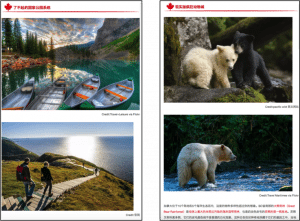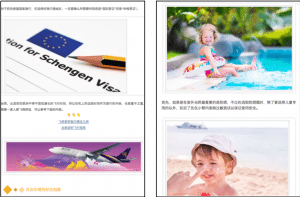Skift Take
China’s number one super app, WeChat, has helped its parent company, Tencent, become the most valuable social network company in the world. With this upward momentum, the app shows great potential for travel brands looking to enter the China market, as long as they formulate a thoughtful strategy going in.
Chinese Internet giant Tencent Holdings Ltd. has surpassed Facebook to become the most valuable social network company in the world, according to Bloomberg.
This milestone came about in part because Facebook’s share price dropped after announcing it would highlight posts by users’ friends and family over those of media and businesses. But, Tencent, which has wide-ranging technology businesses, has been making inroads, spurred by the success of its major social platform, WeChat, for some time.
With nearly one billion reported monthly active users in late 2017, WeChat has integrated its way into everyday life in China, becoming an increasingly appealing tool for global travel brands looking to enter the market and attract the plentiful and high-spending Chinese outbound travel segment. To see a payoff from having a presence on the platform, travel brands must educate themselves about its nuances and they need to formulate a thoughtful, WeChat-specific strategy before jumping in.
Important lessons can be learned from the travel brands already on the platform, including destination marketing organizations, airlines, cruise lines, and hotels. If it’s approached in this manner, WeChat can be key for travel brands looking to unlock the China market.
Last week we launched the latest report in our Skift Research service, WeChat Marketing Strategies for Global Travel Brands 2018.
Below is an excerpt from the Skift Research Report. Get the full report here to stay ahead of this trend.
CONTENT AND CAMPAIGN STRATEGY FOR OFFICIAL ACCOUNTS
Content Themes
One of the main themes that gains a lot of attention on WeChat is nature. This is an especially important theme for WeChat users who live in major Chinese cities. Banff & Lake Louise Tourism, for example, has found that “posts that highlight our beautiful scenery, unspoiled nature, clean air, the fact that we are a natural park and UNESCO World Heritage Site, and the idea of a mountain playground and that we have a pristine, protected environment,” tend to generate high engagement levels.
Tourism Australia has found that content featuring images of the country’s “fluffy, cute animals” is typically received well, and Tahiti Tourisme has found success celebrating the islands’ beautiful scenery with images and information about its famous overwater bungalows.
Humphrey Ho, managing director for Los Angeles of China-based digital agency Hylink, said WeChat users don’t want to see photos of city skylines. Rather, they are drawn to images of national parks and other attractions, where travelers can find nature, music, or food.
Preview and Buy the Full Report
Destination Canada sees high levels of audience engagement with content that includes photos of wildlife and nature. The photos below were included in a post about reasons to visit Canada. The post received over 48,000 views, making it Destination Canada’s most-viewed post of 2017.

Source: Destination Canada, WeChat Official Account post
This leads us to the next content theme that tends to work for travel brands: food and dining. This theme is one that many kinds of travel brands can take of advantage of. Tourism Australia has found that food and wine content has a lot of reach on the platform, and Los Angeles Tourism’s William Karz noted that “food performs exceptionally well” for his team.
From a different perspective, KLM has also noticed that food-related content is well-received for the airline. Director of Social Karlijn Vogel-Meijer said the carrier approaches this theme from an airline perspective, focusing on food in destinations, especially in its homebase of the Netherlands, where the airline encourages travelers to begin their European vacations.
The practicality of content posted on WeChat is important no matter what its topic is. In fact, content that focuses solely on providing useful information to travelers tends to be very well-received. Because WeChat posts allow for the inclusion of long-form content, the information covered can be in-depth. Mailman Group’s Andrew Collins said this makes it easy to include rich itineraries, which stand out as great content on the platform.
This type of useful information is especially important to Chinese travelers who may be leaving China for the first time, are traveling to a certain type of destination for the first time, or are visiting without a guide for the first time. As BrandStory Asia’s Reene Ho-Phang described, WeChat content can help Chinese travelers “know what they should look out for in terms of safety, as well as what items they should bring.”
In a summer-vacation-themed post, Thai Airways included practical information, including advice about applying for a visa to visit the EU and beach safety tips.

Source: Thai Airways, WeChat Official Account post
Preview and Buy the Full Report
This is the latest in a series of research reports, analyst calls, and data sheets aimed at analyzing the fault lines of disruption in travel. These reports are intended for the busy travel industry decision maker. Tap into the opinions and insights of our seasoned network of staffers and contributors. Over 200 hours of desk research, data collection, and/or analysis goes into each report.
After you subscribe, you will gain access to our entire vault of reports, analyst calls, and data sheets conducted on topics ranging from technology to marketing strategy to deep-dives on key travel brands. Reports are available online in a responsive design format, or you can also buy each report a la carte at a higher price.
Have a confidential tip for Skift? Get in touch
Tags: china outbound, marketing, research, skift research, social media, strategy, tencent, tourism, wechat
Photo credit: Chinese travelers can find — and do find — almost everything on WeChat. Annie Spratt / Unsplash.com
